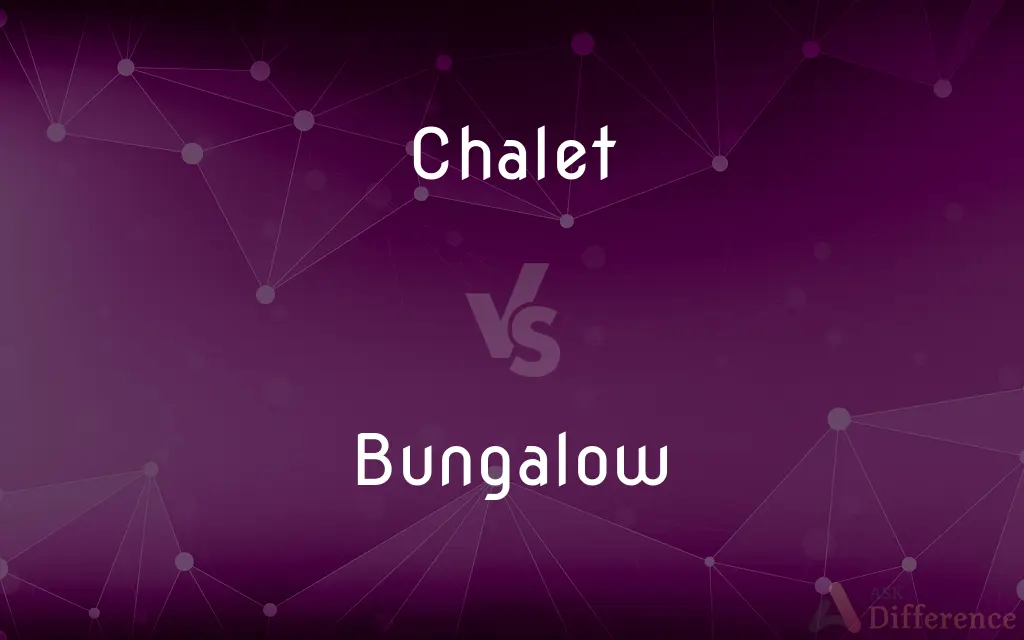Chalet vs. Bungalow — What's the Difference?
By Fiza Rafique & Urooj Arif — Updated on February 29, 2024
A chalet is a type of wooden house with a sloping roof and overhanging eaves, originally designed for alpine regions, while a bungalow is a single-story house, often with a veranda, originating from the Bengal region of South Asia.

Difference Between Chalet and Bungalow
Table of Contents
ADVERTISEMENT
Key Differences
Chalets and bungalows represent two distinct styles of residential architecture, each with its unique characteristics and origins. Chalets, with their roots in the Alpine regions of Europe, are typically made of wood, featuring a prominent, sloping roof designed to prevent snow accumulation. The aesthetic of a chalet is closely tied to mountainous landscapes, and it often includes large windows to take advantage of scenic views and natural light.
Bungalows, originating from the Bengal region in South Asia, are known for their single-story design, broad, low roofs, and verandas. This architectural style became popular in the British colonies, including the United States, during the early 20th century. Bungalows are appreciated for their accessibility and efficient use of space, often featuring open floor plans and minimal exterior decoration.
The key difference between the two lies in their design and intended environment. Chalets are suited for colder, snowy climates, where the sloping roof plays a functional role. Bungalows, conversely, are adapted to warmer climates, with their sprawling layouts and outdoor spaces like verandas providing comfortable living conditions in such environments.
Chalets emphasize rustic charm and integration with mountainous or rural settings, bungalows focus on practicality and ease of access, making them popular in suburban and urban areas. The choice between a chalet and a bungalow often comes down to the buyer's or builder's aesthetic preferences, lifestyle needs, and the climate of the region.
Comparison Chart
Origin
Alpine regions, Europe
Bengal region, South Asia
ADVERTISEMENT
Design
Wooden, with sloping roofs
Single-story, often with a veranda
Climate
Suited for cold, snowy environments
Adapted to warmer climates
Roof
Steeply sloping to prevent snow buildup
Broad and low, sometimes with dormer windows
Key Features
Overhanging eaves, large windows
Open floor plans, accessibility
Environment
Mountainous or rural settings
Suburban or urban areas
Aesthetic
Rustic and cozy
Practical and efficient
Compare with Definitions
Chalet
A wooden mountain house with a sloping roof.
The ski resort was dotted with picturesque chalets.
Bungalow
A single-story house with a broad front porch.
The family lived in a spacious bungalow with a welcoming veranda.
Chalet
Often used as vacation homes in ski resorts.
They rented a chalet for their winter vacation to enjoy skiing.
Bungalow
Popular in warm climates for its indoor-outdoor living.
Their tropical bungalow was designed to maximize breezes through the veranda.
Chalet
Architecture that emphasizes a connection with nature.
The wooden chalet blended seamlessly into the surrounding forest.
Bungalow
Originated as a style efficient for suburban living.
The neighborhood was filled with bungalows, each with its unique design.
Chalet
Typically features overhanging eaves and a cozy interior.
The chalet’s overhanging eaves added to its rustic charm.
Bungalow
Features an open floor plan and easy accessibility.
Their bungalow was praised for its open, airy living spaces.
Chalet
Originating from the Alps, designed for snowy environments.
Their holiday chalet in the Alps featured large windows for the mountain views.
Bungalow
Often includes a low-pitched roof and dormer windows.
The charming bungalow featured a low-pitched roof that added to its character.
Chalet
A chalet (pronounced in British English; in American English usually ), also called Swiss chalet, is a type of building or house, typical of the Alpine region in Europe. It is made of wood, with a heavy, gently sloping roof and wide, well-supported eaves set at right angles to the front of the house.
Bungalow
A bungalow is a small house or cottage that is either single-storey or has a second storey built into a sloping roof (usually with dormer windows), and may be surrounded by wide verandas.The first house in England that was classified as a bungalow was built in 1869. In America it was initially used as a vacation architecture, and was most popular between 1900 and 1918, especially with the Arts and Crafts movement.
Chalet
A wooden dwelling with a low-pitched roof and wide eaves, common in Alpine regions.
Bungalow
A low house having only one storey or, in some cases, upper rooms set in the roof, typically with dormer windows.
Chalet
A cottage or lodge built in this style.
Bungalow
A small, usually one-story house, often having a low-pitched roof, overhanging eaves, and a veranda.
Chalet
The hut of a herder in the Swiss Alps.
Bungalow
A single-storey house, typically with rooms all on one level, or sometimes also with upper rooms set into the roof space.
My aunt can't manage the stairs any more, so she's moving to a bungalow.
Chalet
A summer cottage or country house in the Swiss mountains; any country house built in the style of the Swiss cottages.
Bungalow
A small house with a single story
Chalet
A Swiss house with a sloping roof and wide eaves or a house built in this style
Common Curiosities
Are bungalows suitable for cold climates?
Bungalows can be adapted for cold climates with appropriate insulation and heating, but their design is more suited to warmer weather.
How do the origins of chalets and bungalows influence their design?
The origins of chalets and bungalows heavily influence their design; chalets are built for snowy, alpine conditions, while bungalows were designed for the warm, humid climate of South Asia.
How do lifestyle preferences influence the choice between a chalet and a bungalow?
Lifestyle preferences play a significant role; those who enjoy mountain sports and a rustic aesthetic may prefer chalets, while those seeking practical, accessible living might choose a bungalow.
Can chalets be found outside of mountainous regions?
Yes, while traditionally associated with mountain regions, chalets can be built anywhere, often as a stylistic choice.
Is there a significant cost difference between building a chalet and a bungalow?
The cost can vary widely depending on location, materials, and size, but chalets might be more expensive due to their typically larger size and the cost of wooden construction.
Are there modern interpretations of chalets and bungalows?
Yes, both styles have been adapted into modern architecture, blending traditional elements with contemporary design principles.
Can bungalows have more than one story?
While traditionally single-story, some modern bungalows feature a second story or loft space, though this can blur the lines with other architectural styles.
What is the environmental impact of building a chalet vs. a bungalow?
The environmental impact depends on factors like material sourcing, energy efficiency, and land use, with both styles having the potential for sustainable design choices.
How do interior designs differ between chalets and bungalows?
Chalets often feature cozy, rustic interiors with wood finishes, while bungalows might have a more varied interior design but typically emphasize open, functional spaces.
What makes chalets unique in their design?
Chalets are unique for their wooden construction, steep roofs, and large windows, designed to withstand and embrace snowy landscapes.
Why are bungalows popular in suburban areas?
Bungalows are popular in suburban areas for their efficient use of space, single-story living, and the ease of access they provide.
Can a chalet be considered a bungalow if it's single-story?
While a single-story chalet shares some characteristics with bungalows, its alpine design elements like a sloping roof distinguish it from the typical bungalow style.
What are the key considerations when choosing between a chalet and a bungalow?
Key considerations include climate suitability, lifestyle needs, aesthetic preference, and the desired relationship with the surrounding environment.
What adaptations are necessary for chalets in non-snowy regions?
In non-snowy regions, adaptations might include modifying the roof design and
How do chalets and bungalows differ in their historical significance?
Chalets have historical roots in Swiss Alpine herding life, while bungalows reflect the adaptation of South Asian architectural principles to colonial and then global contexts.
Share Your Discovery

Previous Comparison
Conifer vs. Juniper
Next Comparison
Continuous vs. OngoingAuthor Spotlight
Written by
Fiza RafiqueFiza Rafique is a skilled content writer at AskDifference.com, where she meticulously refines and enhances written pieces. Drawing from her vast editorial expertise, Fiza ensures clarity, accuracy, and precision in every article. Passionate about language, she continually seeks to elevate the quality of content for readers worldwide.
Co-written by
Urooj ArifUrooj is a skilled content writer at Ask Difference, known for her exceptional ability to simplify complex topics into engaging and informative content. With a passion for research and a flair for clear, concise writing, she consistently delivers articles that resonate with our diverse audience.
















































